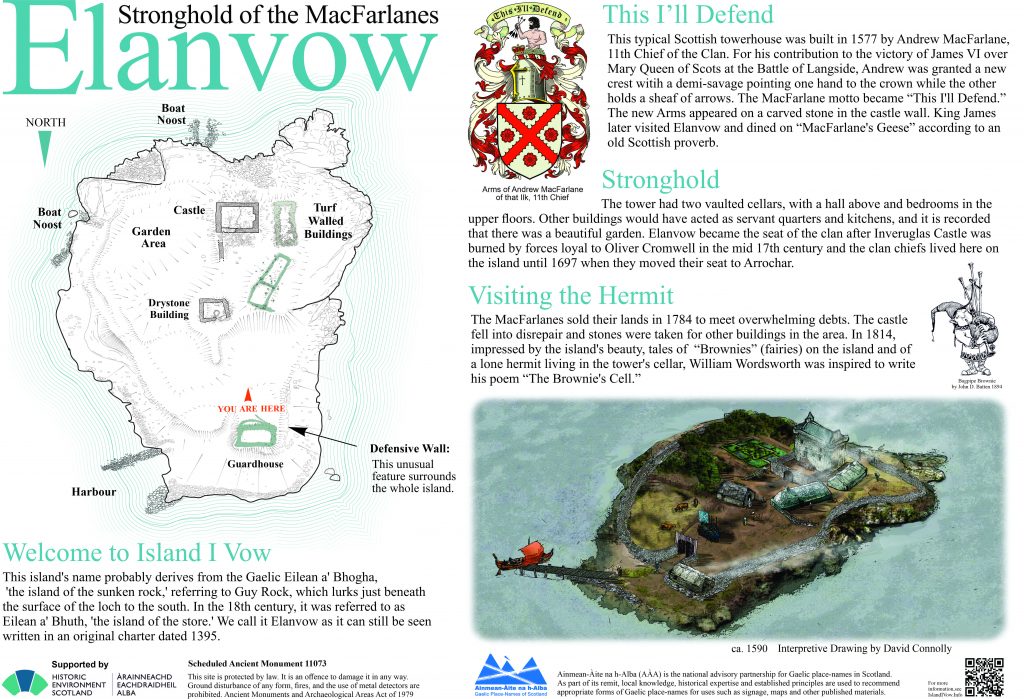
Welcome to Island I Vow!
This site is intended to provide additional information about Elanvow (Island I Vow) to complement the interpretive sign erected on the island. The QR code in the lower right of the sign will link visitors to this site.
We hope you find the sign and supporting information useful and that it inspires all to appreciate and protect this historical site. Island I Vow, including the island and all structures on it, is protected as Scheduled Ancient Monument 11073.
How did the island get its name?
…Malicious Water Sprites?
The earliest writing of the island’s name can still be seen in an existing charter dated 1395 at the Royal Faculty of Procurators in Glasgow. There it is written “Elanvow”. Dr. Eila Williamson of the University of Glasgow has confirmed that transcription. Walter Macfarlane, 20th chief of the Clan MacFarlane, wrote that an earlier charter, dated circa 1215, also referred to Elanvow. The name “Macfarlane” (“MacParlane”) did not exist until after 1263 so this island was called Elanvow even before the name Macfarlane first existed!

Elan, Ellan, Eilean are all variants of Gaelic words for “island”. The island has generally been called Island Vow in many different ways.
There are several interpretations suggesting that Vow may come from Gaelic or even Norse (Viking) roots. In Gaelic, “bh” is pronounced as “v” and there are several Gaelic words that may be the basis for Vow. In about 1590, Timothy Pont made maps of the area and wrote “yl: na Vow” where “yl:” is interpreted as eilean or island and, again, “Vow” appears literally.

Dr. Simon Taylor of the University of Glasgow in “PLACE-NAMES OF THE PARISH OF ARROCHAR”, p11, suggests that Vow may likely come from the same roots as “bode” or “foreboding” and the Gaelic/ancient root of the name is likely Eilean a’ Bhogha. Bhogha refers here to the swell of water warning of a sunken rock. a malicious water sprite, or other nautical hazard and there are similar references to “Vows” elsewhere. Recent research discovered that there is, in fact, a large rock just feet below the loch surface to the south of Island I Vow AND the island was used in nautical charts to warn sailors to navigate around it! Dr. Jacob King of Ainmean-Àite na h-Alba also reviewed and supported the position that Bhogha was the likely root of Vow in the island’s older name. See this site for more.
Expand the sections below for some additional notes.
No Cows involved!
In the mid 20th century, some modern authors speculated that the island might have been named The Island of the Cow, since the later Macfarlanes were noted for cattle rustling and since bó or bhó (lenited) is Gaelic for cow. Even though that romantic notion was popular, it is documented that the name “Vow” was given to the island before Macfarlanes even existed and we are told sternly that the Gaelic grammar would be incorrect as Eilean a’ bhó when we ask native Gaelic speakers. Elanvow did NOT get its name for Island of the Cow. The author who originally proposed this has also retracted that speculation.
Many Variations Over Time
It is also documented that the island was referred to as Eilean Ur (the New Island) for a while after the castle was built there in 1577 and also Eilean a’ Bhùth (Island of the Store or Shop) in the 18th century after the Clan chief had moved to the mainland. See this site for a list of many of the names used for Island I Vow over the centuries.
Write it like it sounds!
The island’s name was often written as “Vow” even by educated people who spoke Gaelic. The 20th Clan chief, Walter, wrote “vow” in his notes even though he knew Gaelic, for example. However, if the person writing the island’s name did not know Gaelic, they would tend to write the name based on the way it sounded. To hear how a native Gaelic speaker would say Eilean a’ Bhogha and Eilean a’ Bhùth, please click the links below. Which would you write as “Vow” with a “w” sound at the end?
Eilean a’ Bhogha
Eilean a’ Bhùth
Even Sir Walter Scott wrote of Island I Vow
In his book “The Monastery”, Sir Walter Scott wrote of the visit of King James VI to the Island of “Inch Tavoe”. “Inch” or Gaelic “Innis” means “island” which leads this to translate as “Island ta voe”. Scott also writes of Invanhoe, where latter ends in a “long o” sound and this may further suggest that Vow was pronounced with a “long o” sound … as in Eilean a’ Bhogha. (Remember that “bh” is pronounced like “v” in Gaelic.)
Macfarlane Arms
Where’s the dungeon?
Wordsworth and The Hermit